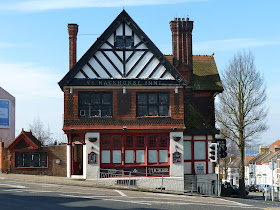No. 212 Elm Grove occupies the corner with Queen's Park Road with great style and confidence. Built in the early 1880s, yet still largely unaltered, it is also a wonderful showcase of the architectural preoccupations of the time; the tudor-revival chimneys, timber-framing, upper sash window panes patterned with glazing bars; the Arts & Crafts style lettering. It is not listed or in a conservation area.
It has recently been closed as a public house, sold, and is now undergoing extensive interior alteration to form one 1 bedroom, one 2 bedroom and one 3 bedroom maisonettes. Among the external alterations the windows will all be replaced with double-glazed black UPVC units and the present front door will be replaced with a window. See BH2012/01177.
A small plot of adjacent land on Queen's Park Road is subject to a planning application BH2012/00280 by C J Planning of Rugby Road, Brighton, for the erection of a 3 bed, 2 storey house. The accompanying design statement includes the comment:-
"A contemporary design approach is considered to be appropriate here as a distinct contrast with the ordered late 19th century terraces on the other side of Queen's Park Road and the ornate “Tudorbeathan” (sic) features of the pub."
The term "Tudorbethan" was, in fact, coined by poet and conservationist John Betjamen to describe the 20th century mock-tudor style. This style is widespread in Brighton's suburbs, e.g. Woodland Drive: it somehow does not seem to carry the conviction or panache of its 19th century predecessor.




What a treat - but UPVC windows. I hope they keep the glass detailing.
ReplyDeleteI would have loved a local like that. We're all mad. We'd rather buy a bottle from a anonomous shed and drink it on our own in front of blaring TV then spend a night out with friends in the local.
I'm too old for this world!!
No, The intricate glazing bars are going I'm afraid.
ReplyDeleteDistant relatives were publicans here (found from census returns) here from pre 1911 to at least 1943 when Clara Woolven (nee Novis) died.
ReplyDeleteWho was the architect ?
ReplyDeleteWho was the architect ?
ReplyDeletewhy was it closed down?
ReplyDeleteAt the bottom of the big chimney is a plaque & an engraving of "Baronet". Who was Baronet ?
ReplyDelete